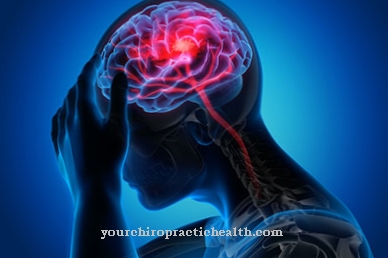A Campylobacter infection or Campylobacteriosis is a contagious gastroenteritis that is caused by the Campylobacter bacterium and must be reported in Germany. In industrialized countries, a Campylobacter infection is the most common bacterially caused diarrhea, along with a Salmonella infection.
What is Campylobacter Infection?
.jpg)
© hikdaigaku86 - stock.adobe.com
Campylobacter infection is a reportable infectious gastroenteritis (intestinal inflammation) that can be traced back to the bacterial pathogen Campylobacter and is associated with a high fever, watery diarrhea and a general feeling of illness.
The Campylobacter infection pathogen is usually transmitted to humans via foodstuffs of animal origin, contaminated drinking water, through contact with infected farm animals (especially poultry) or pets (especially dogs, cats) or directly from person to person (smear infection) .
In the case of a Campylobacter infection, the pathogens spread to all areas of the intestine and damage the intestinal mucosa. In many cases, the bacteria produce a toxic substance (enterotoxin) which is harmful to the human body and which contributes to the development of the characteristic symptoms of a Campylobacter infection.
causes
Campylobacter infection is usually caused by direct or indirect transmission of the Campylobacter bacterium to humans from infected animals, which often do not show any symptoms of the disease.
Campylobacter are gram-negative, spiral-shaped rod bacteria, with Campylobacter jejuni, Campylobacter coli and the less common subspecies Campylobacter fetus being clinically relevant. In the majority of cases of Campylobacter infections, indirect transmission takes place through contaminated food of animal origin and contaminated drinking water.
The Campylobacter bacteria are excreted by the affected animals or humans in the faeces, so that direct or indirect contact with them can lead to transmission (smear infection). Since the necessary amount of pathogen (500 to 1000 bacteria) for a Campylobacter infection is small, this form of gastroenteritis is considered highly infectious.
You can find your medication here
➔ Medication for diarrheaSymptoms, ailments & signs
An infection with Campylobacter bacteria is usually very similar, regardless of the type of Campylobacter bacteria. The first symptoms appear after an incubation period of two to five days. At the beginning there are still unspecific symptoms. The patients generally feel ill and complain of tiredness, headache and body aches and high fever with temperatures of up to 40 ° C.
After this preliminary stage, the inflammation of the intestines often causes the typical symptoms of a Campylobacter infection to set in very suddenly. These are similar to gastrointestinal flu in terms of their characteristics. Colic-like, i.e. swelling and decongesting, abdominal pain occurs and the patients suffer from massive diarrhea. Up to 20 times a day, initially mostly watery, later also bloody-slimy diarrhea occurs.
The disease lasts between a day and rarely up to two weeks before the symptoms usually disappear spontaneously. In the vast majority of patients, the infection heals without any consequences, and complications can only occur in rare cases. So-called reactive joint inflammation (arthritis) can occur very rarely after healing. There is also a suspicion that there is an association with Guillain-Barré syndrome, a rarely occurring inflammation of the nervous system.
Diagnosis & course
A Campylobacter infection is diagnosed on the basis of a pathogen detection in a blood or stool sample. In addition, the symptoms characteristic of a Campylobacter infection provide information about the disease.
After the incubation period (on average 2 to 5 days), headaches, high fever, general malaise and vomiting (vomiting) in around 25% of those affected often occur at the beginning of the disease. In the further course of a Campylobacter infection, spastic contractions (cramp-like pain) in the gastrointestinal area and watery diarrhea (diarrhea) occur.
A Campylobacter infection usually has an uncomplicated course and subsides after an average of 7 days. In isolated cases (10 to 20%, especially in children and immunodeficient) there is the possibility of a recurrence (recurrent Campylobacter infection) or chronic gastroenteritis.
A Campylobacter infection by Campylobacter fetus, on the other hand, has a severe course, since in addition to gastroenteritis, inflammation of other organs can also be present.
When should you go to the doctor?
If you have inflammatory bowel disease and other symptoms suggestive of Campylobacter infection, you should definitely see a doctor. If symptoms such as headache, severe vomiting or a high fever occur, a serious illness is likely - then go to the doctor's office immediately and have the cause clarified. At the first signs of inflammation of the brain, inner lining of the heart, joints or veins, a medical emergency is present.
The affected person must receive emergency medical treatment before further complications arise. People with a weakened immune system - for example due to advanced liver cirrhosis, a malignant tumor or an HIV infection - are particularly susceptible to Campylobacter infection. Likewise newborns and the elderly. In pregnant women, the disease increases the risk of miscarriage.
Anyone who has these factors should see a doctor immediately with the warning signs of Campylobacter infection. In addition to the general practitioner, a gastroenterologist or a specialist in infectious diseases can also be visited. In severe cases, the emergency medical service or the nearest hospital should be contacted.
Doctors & therapists in your area
Complications
Because of the Campylobacter infection, the patient usually suffers from gastrointestinal complaints. This leads to vomiting, fever and headache. Pain also occurs in the abdomen and is often accompanied by diarrhea. In most cases with Campylobacter infection, the patient needs about a week of bed rest and cannot do any physical work during this time.
Food intake is also usually restricted because of abdominal pain and diarrhea. The Campylobacter infection thus leads to a severe restriction in life, which, however, only occurs for a short time. In most cases, treatment by a doctor is not necessary and the Campylobacter infection will subside on its own after a few days. If the infection is serious, antibiotic treatment is necessary.
The dehydration caused by diarrhea must also be counteracted. Usually there are no further complications. If the Campylobacter infection is not treated and persists for a long time, in the worst case it can lead to inflammation of the meninges or the inner lining of the heart. However, these complications are very rare.
Treatment & Therapy
The therapy of a Campylobacter infection, since it is a self-limiting disease, depends on the symptoms. The main aim of the treatment is to compensate for the loss of fluids and electrolytes associated with watery diarrhea. To this end, those affected by Campylobacter infection are advised to increase their fluid intake to compensate.
Infusions may be necessary if there is severe fluid loss. A low-fiber diet (rusks, tea) and the avoidance of stool-stimulating drinks (apple juice) can also help to alleviate the problem. In the more severe course of Campylobacter infection, antibiotic therapy with aminoglycosides, erythromycin or ciprofloxacin is recommended. For extraintestinal infections such as a Campylobacter infection by Campylobacter fetus, antibiotic therapy is part of the treatment plan right from the start.
In addition, Campylobacter fetus spreads to other areas of the body via the bloodstream and can lead to endocarditis (inflammation of the inner lining of the heart), meningitis (inflammation of the meninges), phlebitis (inflammation of venous vessels), abscesses and, during pregnancy, to a miscarriage, so that in addition to Long-term antibiotic therapy may also require the treatment of possible secondary diseases.
Outlook & forecast
The Campylobacter infection causes severe diarrhea and intestinal inflammation. However, it usually heals well even without treatment with antibiotics. However, the disease can break out again in ten to 20 percent of all those affected. This is especially true for children.
The course of the infection is severe and leads to a high loss of fluid that must be compensated for. During infection, the disease is highly contagious via smear infection. In some cases, complications can arise. A mixed infection with other bacteria and viruses is possible, which complicates the course of the disease.
Some sufferers develop reactive arthritis (joint inflammation) one to two weeks after surviving the infection, which usually heals again after a few weeks without consequences. In rare cases, however, chronic courses are also observed.
Another sequelae can be Guillain-Barré syndrome. This is an inflammation of the spinal nerve roots and peripheral nerves. Two thirds of the patients also heal completely here.
The disease can also lead to paralysis up to paraplegia and in about ten percent of cases also to death from heart failure, respiratory paralysis or pulmonary embolism. In immunocompromised patients, an acute Campylobacter infection sometimes ends fatally with the occurrence of sepsis. A chronic course of the Campylobacter infection is also rarely possible.
You can find your medication here
➔ Medication for diarrheaprevention
A Campylobacter infection can be prevented by adequate hygiene. These include, on the one hand, frequent hand washing, the hygienic handling of potentially contaminated food (poultry), the avoidance of raw consumption of these foods and contaminated drinking water, and avoidance of contact with the stool of potential carriers of the Campylobacter pathogens. The infection is notifiable and in some occupational areas (food industry) the occupation may not be practiced if Campylobacter is infected.
Aftercare
In most cases, Campylobacter infection does not require direct follow-up care. Ordinary measures of good hygiene should be followed to speed healing and alleviate discomfort. In most cases, the Campylobacter infection is treated with the help of antibiotics, whereby there are neither complications nor a serious course.
Treatment is not necessary in mild cases of infection. The person concerned must take care of his body and rest, whereby only light food should be consumed. You should also pay attention to the intake of electrolytes in order to compensate for the loss of fluids. When taking antibiotics, the person concerned should make sure that they are not allowed to be taken with alcohol.
If the possible reason for the Campylobacter infection is known, the trigger must of course be avoided and a high standard of hygiene must be observed. The light diet for this infection should consist of apples, rusks, and tea. Only after the symptoms have subsided can normal food be taken again.
Stress can also have a negative effect on the course of the disease and should be avoided. In most cases, the disease progresses positively, and the patient's life expectancy is not reduced either.
You can do that yourself
In order to compensate for the water and electrolyte loss caused by the severe diarrhea, increased fluid intake is extremely important in the case of a Campylobacter infection. Water, slightly sweetened herbal teas or an electrolyte solution that can be bought ready-made at the pharmacy or made from water or tea, table salt and glucose yourself are well suited for this.
Carrot soup is a tried and tested home remedy for diarrhea, an oatmeal or rice soup also provides the body with the necessary fluids and nutrients and also calms the irritated intestinal mucosa. Rusks, grated apples and bananas are also easy to digest. Fatty and gasping foods, alcohol and caffeine should be avoided in campylobacteriosis until the digestive system has calmed down completely.
Healing clay dissolved in water binds toxins in the intestines and can help to remove pathogens from the body more quickly. When it comes to medicinal herbs, oak bark, cinquefoil and lady's mantle are used in particular for severe diarrhea; dried blueberries also have a constipating effect due to their high tannin content.
In addition to bland foods and an increase in the amount you drink, rest and avoiding stress promote healing. Due to the high risk of infection, contact with other people should be limited to what is absolutely necessary and strict hygiene should be observed during the Campylobacter infection. If the disease worsens despite self-treatment, a visit to a doctor is strongly recommended.


.jpg)
.jpg)

.jpg)








.jpg)













